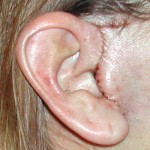
Fundamentally, one part of a facelift incision must run down in front of the ear. In women, this incision actually goes inside the ear starting just above the tragus, that piece of skin (and cartilage) that actually sticks out in front of the ear hole. Once on the backside of the tragus, it comes back out and down along the earlobe in a natural skin crease. Once behind the ear, the incisions runs in the crease of the ear and up. This basic incision pattern is what is used for all types of facelifts, whether they be limited or full. In the limited or mini-facelift, also known more popularly as the Lifestyle Lift, no more incision is needed. For more complete facelifts, which we will refer to here as full facelifts, extensions of this basic incision pattern are needed to work out more skin. In front of the ear, the incision will go higher up in the temporal hairline. In the back of the ear, it will go off from the crease back into the occipital hairline in a more horizontal direction.
In men, there is a slight variation of where the incision goes in front of the ear due to beard skin. Placing the incision behind the tragus in a man will place beard skin inside the ear. That is not a popular or desireable place to shave. While there are certainly good methods today for reducing or eliminating unwanted hair, it is probably best to avoid that problem from the beginning. Therefore, it is most common that the incision runs down in the natural skin crease between the ear and face, in front of the tragus. While this does place the scar in a more visible location, this heals so well in most men that it is not a signficant concern.
The placement and healing of facelift scars is of great importance and most facelifts will be judged by how they look.
Dr. Barry Eppley
Indianapolis, Indiana


